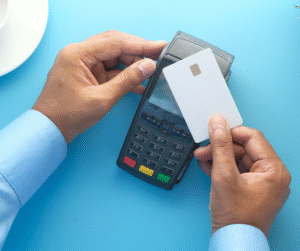How do credit cards work? A beginner’s guide to fees, APR, and rewards
Curious about how credit cards work? This beginner’s guide explains the key terms, fees, APR, and rewards to help you.
Credit cards are everywhere and used for everything from groceries to flights, but understanding how they actually work can feel overwhelming.

Whether you’re thinking about applying for your first card or just want to better manage the one in your wallet, knowing the basics can help you make smarter financial decisions. So, how do credit cards work? Let’s break it down.
What is a credit card, really?
A credit card is a financial tool that lets you borrow money from a bank or credit card issuer to make purchases. Unlike a debit card, which pulls funds directly from your bank account, a credit card gives you a line of credit you’re expected to pay back, either in full or over time.
Each time you use the card, you’re borrowing money. The bank keeps track of your spending and sends a monthly statement with your balance, minimum payment, and due date.
Key terms you need to know
Understanding a few core terms will help you make sense of how credit cards function:
- Credit limit: this is the maximum amount you can borrow on the card.
- APR (Annual Percentage Rate): the interest rate you’ll pay on balances you carry from month to month.
- Grace period: a window, usually around 21 days, when you can pay off your balance without interest.
- Minimum payment: the smallest amount you must pay each month to avoid late fees and credit damage.
The cost of convenience: fees and interest
Credit cards offer flexibility, but that convenience often comes with fees. Some common ones include:
- Annual fees: some cards charge a yearly fee just to have the card.
- Late payment fees: charged if you miss your due date.
- Foreign transaction fees: a small percentage added to purchases made abroad.
- Cash advance fees: extra costs when withdrawing cash from an ATM using your credit card.
Interest is another major cost. If you don’t pay your balance in full, you’ll owe interest, often at a high APR. Carrying a balance month to month can lead to debt that grows faster than expected.
The perks: how rewards work
Many credit cards offer rewards programs as an incentive. These might include:
- Cash back: earn a percentage of your spending back as a statement credit or deposit.
- Points: collect points to redeem for travel, gift cards, or merchandise.
- Miles: perfect for frequent travelers, miles can be used to book flights or hotels.
While these rewards can be appealing, they only truly benefit you if you avoid interest and fees. Otherwise, the cost can outweigh the perks.
Using credit cards wisely
Credit cards can help you build credit, earn rewards, and manage cash flow, but only if used carefully. Here are a few simple tips:
- Pay your balance in full each month to avoid interest.
- Set up autopay to never miss a due date.
- Monitor your spending so you stay within your budget.
- Review your statement monthly to catch errors or fraud.
Credit confidence starts with understanding
Knowing how credit cards work is the first step toward using them responsibly. Once you understand the terms, costs, and benefits, you’ll be better equipped to choose the right card and avoid common pitfalls.
Credit cards aren’t one-size-fits-all, and they’re not “free money”, but with a little knowledge, they can be a practical and useful part of your financial toolkit.





